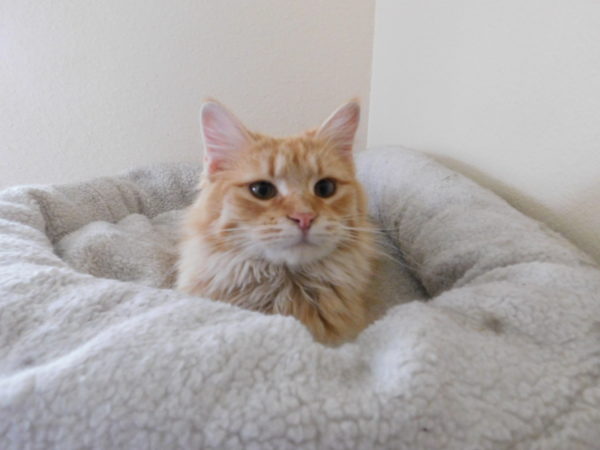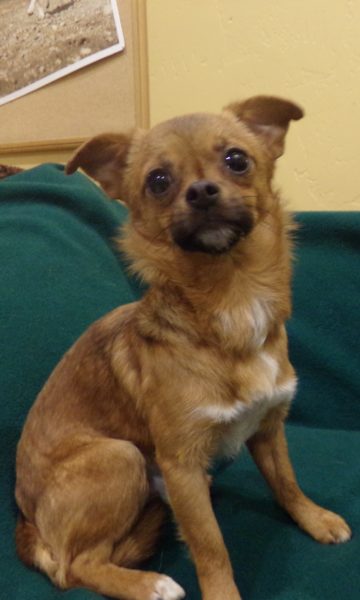
21 Mar Second Chance: Cats & Cavities
Dear Pet Column,
Do cats get cavities?

Tango
Here is a mostly unknown feline fact: cats don’t get cavities like humans do. Instead we get something called cat tooth resorption. To add to the allure of the mysterious cat, no one really knows what causes it. But here is what you should know about it…
So think about teeth. The outermost layer above the gums is the enamel. It’s very thin, but it’s the toughest part of the tooth. (Another fun fact: enamel is the hardest substance in the body — human or feline.)
The next tooth layer takes up the most room. It’s made from a bone-like material called dentin. Inside is a very soft substance: the pulp of the tooth. A lot goes on here. That is the rich environment that feeds and nourishes the tooth and it serves as the tooth’s nerve center. These are the tooth’s security and alarm systems, letting its host know when something’s wrong by sending signals of sensitivity or pain.
Tooth resorption is the process whereby a substance is absorbed back into its surrounding tissues. Whereas a cavity occurs when erosion or decay is present, with tooth resorption the outer layers begin to be eaten away, absorbed into internal layers. In many cases, the roots reabsorb into the surrounding flesh until nothing remains but soft tissue. At that point, the tooth is irreparably damage, and there is no option but to remove it.
As resorption progresses and the nerve center is exposed, a cat can experience a great deal of pain.
Cats are notorious at hiding pain, so you will have to pay very close attention to notice the suffering. Look for drooling, a preference for eating on one side of the mouth, or suddenly starting to swallow food whole. If your cat will let you, look at his teeth and see if you notice any red spots or holes on the tooth.
As yet, the cause of the resorption is undetermined, although a few studies suggest one culprit: the amount of Vitamin D in a cat’s diet.
Cats cannot absorb vitamin D through their skin (all that sunbathing for nothing!) and need to get if from their food. So vitamin D is added into most cat food – unfortunately often in excess. (In some foods, up to 30 times more than necessary!)
Currently the thought is that excessive vitamin D intake or low vitamin D serum levels can both lead to tooth resorption. To complicate matters, most pet food labels list vitamin D as a supplement, but don’t include the amount. But as there’s no definitive research about how much is good or bad for a cat, that oversight really doesn’t matter.
The solution? Take your cat in for dental checkups twice a year instead of just at the annual wellness exam. Attempt (heh) brushing your cat’s teeth to remove plaque or rubbing an anti-inflammatory such as Ellagic fatty acid complex on the gums.
My name is Tango. I am a beautiful one-year-young female orange longhair tabby – with good teeth. I am a love-bug who likes other cats just fine, but loves people more. And yes, I do like tango dancing, but lately have taken an interest in knitting.

KODAK Digital Still Camera
The featured dog of the week is Eddie, a handsome Chihuahua mix here at Second Chance Humane Society.
Eddie is about one-year-old and a little bundle of sweetness. He gets along well with other dogs, loves being around people and will cuddle on your lap. Eddie is learning basic and leash training and is just a fun guy to have around.
Editor’s note: It’s no secret. The Telluride region is dog heaven. Well, pet heaven. Unless you are one of our furry friends who gets caught in the maw of neglect and abuse. Then heaven is on hold until Second Chance Humane Society comes to the rescue. Second Chance is the region’s nonprofit dedicated to saving animals’ lives and promoting responsible pet parenting and human-animal bond. In her weekly blog, executive director Kelly Goodin profiles at least one, generally two of the many animals now living at the no-kill shelter, Angel Ridge Shelter, a dog and a cat, hoping to find them loving permanent homes. The column is sponsored by Ted Hoff of Cottonwood Ranch & Kennel, who from time to time exercises his skills as a dog whisperer, partnering with Kelly and her staff to help train a particularly challenging animal.

Ted Hoff with Cabella & Wilbur
By the by, there is no better place to park your pup or get your pup (or adult dog) trained than Cottonwood whenever you head out of town (for locals) or are heading to town and staying somewhere that does not allow pets. Consider joining Ted’s Very Important Dog (VID) Club for added benies. (Details on Ted’s website.)
Second Chance Humane Society Animal Resource Center and Thrift Shop are both located in Ridgway, but service San Miguel, Ouray & Montrose Counties. Call the SCHS Helpline at 626-2273 to report a lost pet, learn about adopting a homeless pet, or about the SCHS Spay/Neuter, Volunteer, Feral Cat, or other Programs. View the shelter pets and services online: www.adoptmountainpets.org
Vetting the Vet: Dr. Michelle Dally, DVM, J.D. is Medical Director of Second Chance Humane Society. She also has a private practice, Dally Veterinary Medicine, 333 S. Elizabeth Street, Ridgway, Colorado. Her service area is San Miguel Mesas, Placerville, Ridgway, Ouray, and Montrose. For more on Dr. Dally, go here.

Michelle & Wallowby


Sorry, the comment form is closed at this time.